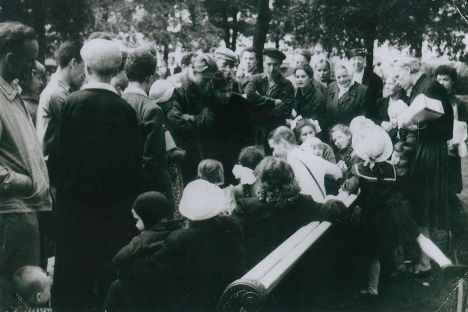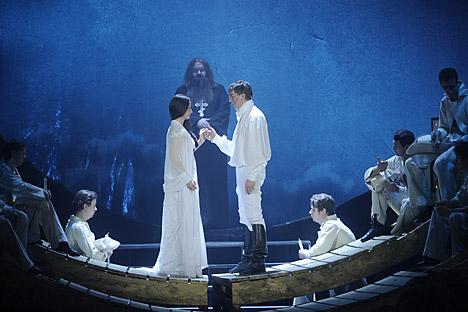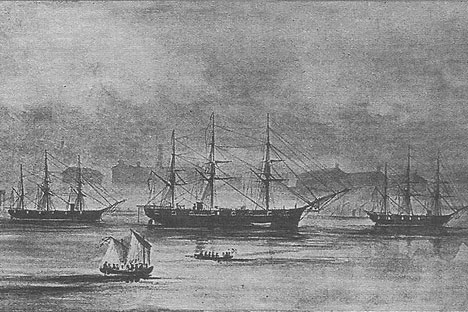James Symington: The architect of modern U.S.-Russian cultural exchange

James Symington plays guitar and sings on the park bench in Moscow.
Press PhotoThere are certain givens in life that a Russian and an American would unlikely argue about. For example, that the perfect venue for a first date is a bench in a park.
It was the summer of 1958. Having newly arrived in Moscow, young American, James Symington, looked for the ideal spot to introduce himself to Russia. He took his guitar, found a cozy bench in a Moscow park and started singing. He was soon surrounded by curious Russians. Their first question was:
“Are you an American?”
Symington had arrived in Moscow a year ahead of the famous American National Exhibition at Sokolniki and most Muscovites had never met an American before.
The young man played guitar, sang songs and answered questions, communicating by an improvised sign language. Recollecting that time, Symington says that the sincerity of those passers-by and their eager questions exhilarated him. He went to the same park for the next several days and each time his interest in the Russian people grew.
Returning home, Symington decided to learn more about Russia. He began studying Russian and taught himself to sing Russian songs. As a result, long before the appearance of the Juno and Avos rock opera about the first Russians landing in Northern California, he volunteered to write a libretto for an opera about diplomat Nikolay Rezanov and his love affair with a San Francisco commandant’s daughter, Conchita.
Symington did not always have to seek out Russian touches in the world around him, sometimes they just found him. In the office of a business acquaintance in St. Louis, Mo. Symington noticed a huge painting of a forest fire. The artist’s signature was in Russian.
Symington did some research and discovered that the artwork was one of the paintings that had disappeared from the Russian exhibition in St. Louis in 1904. He subsequently worked to have the painting rightfully returned. An archival photo shows Symington and U.S. government official Joseph Duffey presenting the painting to Soviet Ambassador Anatoly Dobrynin (from 1962-86) at the Soviet Embassy.
Symington’s interest in Russia served him well during his years in the U.S. Congress. As chairman of the Subcommittee on International Cooperation in Space, Congressman Symington (D-MO) took part in implementing the Apollo-Soyuz Project and got to know American and Soviet astronauts.
After the break-up of the Soviet Union and the emergence of the Russian Federation, Symington headed a new public organization, the American-Russian Cultural Cooperation Foundation (ARCCF) in 1993. Thanks to his enthusiasm and energy, Washington has a larger than life-size monument to Pushkin, while Moscow received a monument to Whitman, both created by Moscow sculptor Alexander Burganov.
Symington also initiated an ambitious program of travelling exhibitions. With his vision, a number of exhibitions from leading Russian museums were shown in many U.S. cities.
It is worth noting that long before the current legal problems affecting Russian-American exhibition exchanges, a similar situation occurred in 1997. Because of a lawsuit by American relatives of the owners of a St. Petersburg piano factory confiscated after the 1917 Revolution and a Texas court decision in their favor, Russian museums stopped sending their treasures to the U.S. Symington invested his time and funds toward resolving the dispute. Thanks to his monumental endeavors exhibition exchanges resumed, allowing our countries to continue learning more about each other.
Through various ARCCF programs under Symington’s guidance many pages of the two countries’ shared history were rescued from oblivion. For example, Russian explorations in Northern California and Alaska, solidarity of Russia with the U.S. during the War of 1812, the Russian Navy’s visits to New York and San-Francisco in 1863 in support of the Union and the Elbe River meeting at the end of WWII, to name a few.
Symington can call many influential Russians his friends: cellist Slava Rostropovich, choreographer Igor Moiseyev, conductor Valery Gergiev, saxophonist Igor Butman, poet Yevgeny Yevtushenko, writer Edward Radzinski, sculptor Alexander Burganov, Director of the State Archive Sergey Mironenko and directors of many Russian museums. He has awarded many of them with the ARCCF’s Foundation Award for their contributions to American-Russian cultural relations.
In 2008, by Russian Presidential decree, Symington was decorated with the Order of Friendship. On Nov. 17, the ARCCF is holding a gala dinner at Russian Ambassador Sergey Kislyak’s residence to honor its chairman.
On one of the benches in Moscow’s Gorky Park a plaque commemorates his 1958 debut in the sphere of American-Russian relations.

On a similar bench in July 1958 James Symington was playing a guitar and singing American songs in Moscow. Source: Press Photo
Another plaque will be placed on a wooden bench presented to Symington in Washington at the event in his honor:
“It is on a similar bench in July 1958, an American national, Jim Symington, was playing a guitar and singing American songs in the hope of establishing a cultural dialogue between the U.S.S.R. and the U.S.A. (1958-2015).”
Alexander Potemkin is the Executive Director of the American-Russian Cultural Cooperation Foundation in Washington, D.C., Prior to joining the Foundation he served as cultural attaché for both the Soviet Union and the Russian Federation.
All rights reserved by Rossiyskaya Gazeta.
Subscribe
to our newsletter!
Get the week's best stories straight to your inbox

